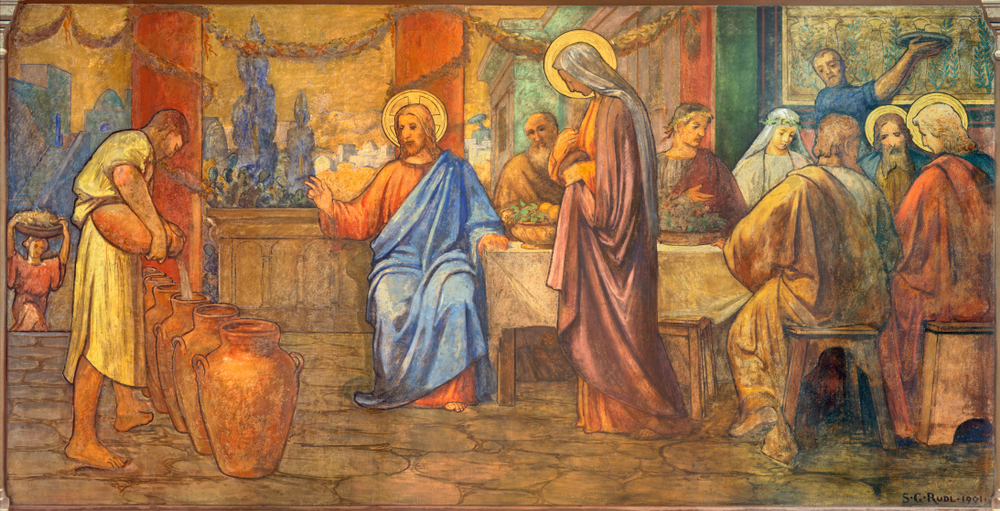This post is part of an ongoing series in the study of John we are doing during January. Subscribe to the blog for daily updates in the Bible Study posts. Subscribe to the podcasts to hear our discussion of the book of John throughout this month. Join us in your daily devotions as we travel through this fascinating account of the life of Christ.
***
On the third day there was a wedding in Cana of Galilee, and the mother of Jesus was there. Now both Jesus and His disciples were invited to the wedding. And when they ran out of wine, the mother of Jesus said to Him, “They have no wine.” Jesus said to her, “Woman, what does your concern have to do with Me? My hour has not yet come.” His mother said to the servants, “Whatever He says to you, do it.” Now there were set there six waterpots of stone, according to the manner of purification of the Jews, containing twenty or thirty gallons apiece. Jesus said to them, “Fill the waterpots with water.” And they filled them up to the brim. And He said to them, “Draw some out now, and take it to the master of the feast.” And they took it. When the master of the feast had tasted the water that was made wine, and did not know where it came from (but the servants who had drawn the water knew), the master of the feast called the bridegroom. And he said to him, “Every man at the beginning sets out the good wine, and when the guests have well drunk, then the inferior. You have kept the good wine until now!” This beginning of signs Jesus did in Cana of Galilee, and manifested His glory; and His disciples believed in Him. After this He went down to Capernaum, He, His mother, His brothers, and His disciples; and they did not stay there many days. John 2:1-12 (NKJV)
The first question that springs to mind when I read this passage is, “Why is this here?” We have spent the past 51 opening verses exploring deep philosophical insights about the nature and person of Christ. We saw the deeper reality of who John the Baptist was and what he represented. We met the first followers of Christ and encountered the powerful posture of the seeking heart. Suddenly, the story of the wedding in Cana is dropped in. It feels out of place, almost like a party trick that does not fit with the more profound messages we have so far explored in John’s gospel.
That impression is wrong, of course. The message and depth of this gospel have not suddenly shifted in chapter 2. We are still looking at the deep realities of Christ. We are still seeing the Word made flesh and beholding His glory. If the tone and nature of the gospel have changed in our reading, we need to re-read and consider it again.
The Purpose of the Passage
Verse 11 reveals the purpose of this passage: What Jesus did here in Cana of Galilee was the first of the signs through which he revealed his glory; and his disciples believed in him. John 2:11 (NIV)
We could rewrite this verse to state, “This is the first example of how Jesus revealed His glory we were talking about in the last chapter and as mentioned at the end of that chapter, His followers saw this and believed.”
I think this is an important insight when studying the Bible. There is a flow to the message conveyed in scripture. Very seldom does the Bible abruptly change course in the message presented. There is a flow of thought in most passages of scriptures from one to the next. A passage may stand on its own, but that does not mean it was designed to be understood alone.
The insight presented throughout chapter 1 continues here at the opening of chapter 2. There is a reason this passage is here.
The Sign and the Revealed Glory
The miracle at Cana may look like a magic trick, but there is more going on here. To understand what is taking shape, we must ask the right question. That is the clue given to us in verse 11. What was the sign, and how was His glory revealed?
As we read in this passage, this first sign is linked to a wedding feast. There is another wedding feast spoken about in which Christ is present. This other wedding feast is mentioned in Revelation 19. It is the wedding supper of the Lamb.
Then I heard what sounded like a great multitude, like the roar of rushing waters and like loud peals of thunder, shouting: “Hallelujah! For our Lord God Almighty reigns. Let us rejoice and be glad and give him glory! For the wedding of the Lamb has come, and his bride has made herself ready. Fine linen, bright and clean, was given her to wear.” (Fine linen stands for the righteous acts of God’s holy people.) Then the angel said to me, “Write this: Blessed are those who are invited to the wedding supper of the Lamb!” And he added, “These are the true words of God.” Revelation 19:6-9 (NIV)
The beginning of Jesus’s ministry, the first of His signs, casts our vision forward to His ultimate objective. He did not come only for the cross and the resurrection. He came to initiate the great celebration when the bride of Christ is united to Him in eternity. The miracle at Cana, the first of Jesus’ signs, is loaded with symbolism and imagery that tilts our gaze toward His ultimate purpose and missions.
Signs and Symbols
The six waterpots were set aside for purification according to custom. Notably, there were six of these, a number that frequently represents mankind in scripture. For example, Adam was created on the sixth day. The mark of the beast, 666, in Revelation 13, is described as the number of man in verse 18 of that chapter.
In the six purification waterpots, we have an image of the inadequate purification processes of man. Man’s efforts at purity can no more produce the required results than water substitute the need for wine at the wedding. A miracle was needed.
The wine miraculously comes out of these pots is a foreshadow of the infilling of the Holy Spirit, referred to as the new wine in Matthew 9:17.
In John 2, Christ is the Word made flesh standing among the people. He represents the opening of a new era of grace in which the grace, the access, the glory of God being poured out is more magnificent than anything that preceded. As the master of the wedding feast stated at the wedding at Cana, “Every man at the beginning sets out the good wine, and when the guests have well drunk, then the inferior. You have kept the good wine until now!”
As we, the church, prepare for the wedding supper for the Lamb, He has poured out a new wine of grace for us. It is a wine that no human vessel or human design could produce. It is a miracle. That miracle is meant for our joy and celebration because it brings us to the purposed designs of Christ at the end of time.
The wedding in Cana signifies the mission of Christ to miraculously change the nature of man and make us suitable for the requirements at the marriage supper of the Lamb.
Subscribe to the blog as we continue our walk through the book of John tomorrow.
[email-subscribers-form id=”2″]
Be sure to verify by email when you subscribe!





What do you think?
Show comments / Leave a comment